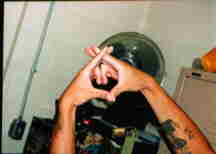Joining a Gang: How to Help Kids Prevent it, How to Tell if They've Joined One, How to Help Them Out
by SixWise.com
While youth gangs are nothing new -- they've been traced back to the
early 19th century -- the demographic of a youth gang is something that
is constantly changing. Many people stereotype gang members as urban,
inner city males from racial minorities, but in fact gangs are a problem
in suburbs as well as cities, for all races and for girls as well as boys.
There are about 750,000 gang members in the United States, according
to estimates by the U.S. Department of Justice, and one-third of them
are under the age of 18. And while it's still true that men account for
the majority of gang members-more than 90 percent are male-gang membership
among women is becoming increasingly common.
|
Signs Your Child May be in a Gang
-
Red or blue or professional sports team baseball hats worn
toward one side or backward
-
Red or blue bandanas worn on the head, tied to a belt
loop or sticking out of a pocket
-
White T-shirts worn under plaid shirts, worn open
or buttoned only at the collar
-
Jeans or pressed Khakis (along with other items)
-
Colored Shoelaces
-
One pant leg rolled up
-
Baggy, oversized pants with boxers showing
-
Teardrop or spider web tattoos on neck or next to
thumb
-
Tattoos or words on knuckles
-
Gang names tattooed on body
-
Hand signs used as a form of communication
-
Drawing gang-related graffiti (crowns, stars, hearts,
pitchforks, gang's name)
-
Friends belong to gangs
-
Using a nickname or "pet" name
-
Spending lots of time away from home
-
Doing poorly in school, or dropping out
-
Sudden increases in material possessions
- Continually wearing the same color combinations
|
What Exactly is a Gang?
Every gang has its own requirements and characteristics, but the U.S.
Department of Justice says that all gangs have one thing in common: "A
group must be involved in a pattern of criminal acts to be considered
a youth gang."
Similarly, the Federal Bureau of Investigation (FBI) defines a gang as,
"A criminal enterprise having an organizational structure, acting
as a continuing criminal conspiracy, which employs violence and any other
criminal activity to sustain the enterprise."
Additionally, gangs typically:
-
Develop around racial and ethnic lines
-
Are typically male-dominated with some female members, though
female gangs are on the increase
-
Center on a specific territory
-
Act as an organization that may be part of a larger group
- Display symbols associated with their gang through clothing,
tattoos, graffiti, hand signals and language
Why do Kids Join Gangs?
According to a White House fact sheet for the new youth initiative aimed
at protecting America's youth from gangs, an overwhelming number of violent
U.S. criminals like those in gangs grow up in single-mother households
with no father around. It's also been shown that kids who are involved
with their family, school and community are less likely to be involved
in risky behavior like joining a gang.
This may explain why, generally, kids join gangs to feel like they belong
and have a sense of purpose. In fact, kids join gangs for many of the
same reasons that kids join any group, like a soccer team or Boy Scouts:
-
Looking for a sense of self-worth, belonging and commitment
-
Seeking structure and discipline
-
Companionship
-
A need for recognition, higher status and acceptance
- Excitement and something to do
|

Kids in gangs often use elaborate hand signs as forms of communication.
The sign above means "cash flow."
|
Additionally, kids may join gangs because of a:
-
Need for protection
-
Family tradition
- Need for money (kids in gangs can earn cash from drug trades)
How to Keep Your Kids Away From Gangs
Since most kids who join gangs do so because they are looking for a social
network, for a group to belong to, ensuring that your child gets plenty
of love and support at home and through positive activities is key in
keeping them away from gangs.
Such was the case with David Danisa, a young man who could have easily
fallen prey to gangs himself as friends around him joined steadily. Instead,
Danisa and friend Jurell Spivey joined school programs and even got involved
into keeping younger kids out of gangs.
"There's a lot of pressures in high school," says Danisa. "If
you have people who are helping you out in programs, you start having
more self-respect. You can fight through the hard stuff." And, to
put is simply, after your day gets filled up with sports, volunteering
and other activities, "You don't have time to do anything bad,"
Danisa said.
Aside from enrolling your kids in community or school youth programs
from an early age, the following tips can also help:
|

These drawings are national symbols of gangs identifying themselves
as "Folks."
|
|
|
|

These drawings are national symbols of gangs identifying themselves
as "People."
|
-
Encourage your child to think independently
-
Take an active interest in his/her life: Be involved!
-
Get to know your child's friends and encourage healthy friendships
-
Teach your child coping strategies to deal with hard times
-
Support your child with words and actions to instill in them a sense
of self-esteem and personal responsibility
- Discourage too much exposure to media influences that glorify drugs,
sex, gangs and violence to kids
Resources That Can Help
If you suspect your child, friend or family member is in a gang and in
need of help, there are many resources available. First, according to
the Los Angeles' County Sheriff's Department:
-
The member must think and believe that they can get out
of the gang, and must want to do it.
-
Reduce the amount of time spent with the gang. It's best
to do so gradually, rather than trying to sever all ties immediately.
-
Replace gang activities with positive activities like sports,
the arts, employment, religion, education, volunteering, etc.
-
Remove gang tattoos and attire and modify language away
from gang communications.
-
Create a new set of friends and an alternative support system,
such as boys and girls clubs.
- Help other youths in gangs to create a better life away
from the gang.
Other helpful resources include:

Monster:
The Autobiography of an L.A. Gang Member
This book gives a gripping account of a world most of us will never
see-the world of the notorious gang, the Crips. "Monster"
follows one boy through a mind-blowing rough start in life on through
his remarkable transformation. Once you start reading this book
you won't be able to put it down ... but be warned that it can
be extremely graphic in its details.
Read
More Now
|
Sources
SafeYouth.org
Gangs Fact Sheet
Bush
Initiative Aims to Reduce Influence of Gangs on Youth
Gangs: Awareness
and Prevention
Mentors,
Activities Keep Kids Out of Gangs
How to Get Out of a Gang